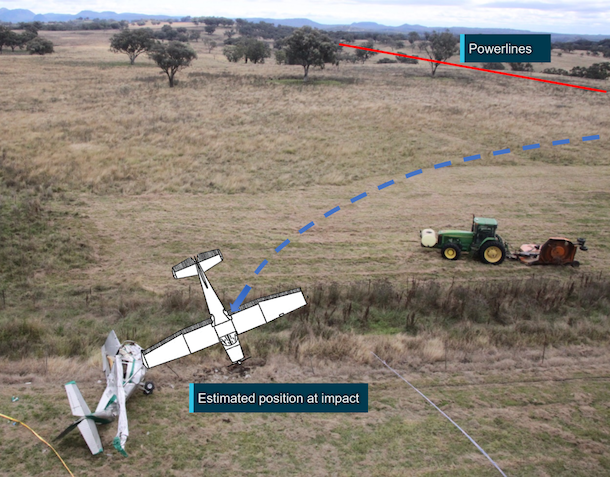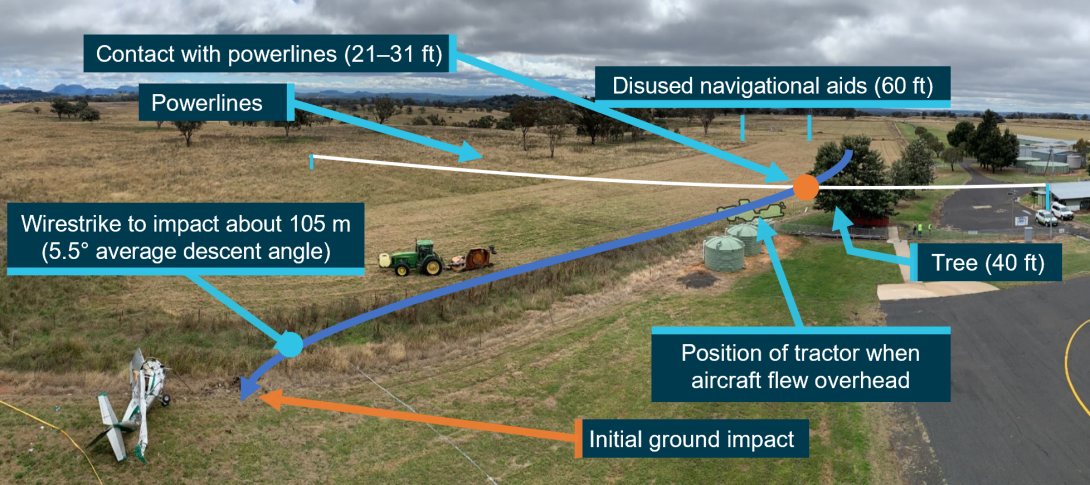Pilot Attempts Intentional Low-Level Pass, Wirestrike & Crash (How far away is death?)

A Cessna 172 pilot was very likely conducting an intentional low-level pass over a tractor before the aircraft struck a powerline, an Australian Transport Safety Bureau (ATSB) investigation details.
The Cessna pilot, flying solo, had been conducting circuits at Coonabarabran Aerodrome on April 18, 2022, before it flew an intentional low-level pass, subsequently contacting power lines and impacting terrain. The pilot was fatally injured and the aircraft was destroyed.

“After completing several touch-and-go landings, the pilot flew a pass at 15–25 feet above the ground over a tractor, which was working in a field adjacent to the aerodrome,” ATSB Director Transport Safety Dr. Mike Walker said.
In the vicinity of an airfield, operations at low level are normal during take-off and landing, however, the Cessna 172 aircraft’s flight path just prior to the collision did not align with the runways, and was not consistent with a normal circuit pattern.
“It was therefore very likely the Cessna pilot was conducting an intentional low-level pass over the tractor,” Dr. Walker said.
“Operations at low height expose an aircraft to several hazards like power lines, which are typically very difficult to see and present a critical hazard to any low-flying aircraft,” observed Dr. Walker.
In recognition of this and other specific risks and hazards of low-level flying, the Civil Aviation Safety Authority requires pilots to hold a specific low-level rating before flying at low level.
“Even with appropriate training, flying at low-level carries a significant risk and should be avoided when there is no operational reason,” Dr. Walker continued.
“For most private pilots, there is generally no reason to attempt an intentional low-level pass, except during takeoff and landing, or conducting a forced or precautionary landing.”
The investigation also notes the Cessna pilot was found to be wearing only the lap portion of the seatbelt. However, it was not possible to determine with certainty whether, if worn, the seatbelt’s upper torso restraint would have reduced the severity of injuries.
“Nonetheless, pilots should always wear upper torso restraints where available,” Dr. Walker said.
“Research has shown that wearing an upper torso restraint significantly reduces the risk of serious or fatal injury.”
What has been done as a result
Based on a risk assessment conducted by the electricity provider post-accident, aerial safety markers were fitted to the power lines in the field adjacent to the aerodrome where the aircraft contacted power lines.
Read the ATSB investigation report: “AO-2022-027 Wirestrike and collision with terrain, involving Cessna 172, VH-REU, Coonabarabran Aerodrome, New South Wales, on 18 April 2022.” Publication date:23/02/2023. Final report: “AO-2022-027 Wirestrike and collision with terrain, involving Cessna 172, VH-REU, Coonabarabran Aerodrome, New South Wales, on 18 April 2022.”
Source/credit for content and photo: ATSB, “Wirestrike and collision with terrain, involving Cessna 172, VH-REU, Coonabarabran Aerodrome, New South Wales, on 18 April 2022.”
TapRooT®’s experts in incident facilitation, root cause analysis, and corrective actions can help your organization solve critical internal and external problems.
When your company is in a situation that requires outside help, TapRooT®’s Root Cause Analysis experts can partner with your employees to identify and solve problems.
TapRoot® is global—and local—to meet your needs. If you would like us to teach a course at your workplace, please reach out here to discuss what we can do for you, or call us at 865.539.2139. Need other times or locations that you don’t see on today’s list? Please see our full selection of courses.



